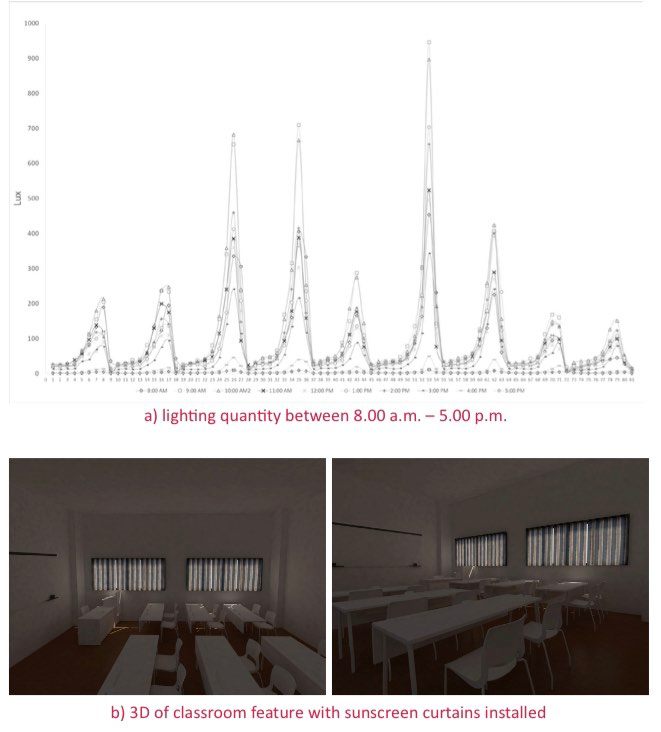The Study of Sunscreen Curtain from PET Bottle Yarn and Its Lighting Quantity for Classroom
DOI:
https://doi.org/10.56261/built.v19.246525Keywords:
sunscreen curtain, PET plastic bottle,, Yarn, Lighting, ClassicAbstract
Currently, the use of environmentally friendly materials is increasing rapidly, all sectors have been focusing on environmental issues with emphasis on recycled materials. The objective of this research was to produce a yarn from PET plastic bottles (used drinking water bottle) for sunscreen curtains in classroom of Rajamangala University of Technology Thanyaburi. The method of research was based on studying the yarn property of PET plastic bottles of sunscreen curtain with a prototype 0.90 x 1.20 m through ASTM and lighting quantity measurement in the classroom. The results found that the yarn property: the mean strength, the mean toughness, the tensile stretch before breaking, and the mean percentage of elongation before breaking was 3,025.92 cN., 5.74 gf/den, 37.46 mm., and 149.83% respectively. Also, the average weight and thickness were 311.87g/m2 and 0.14 mm. The tensile strength of the warp fabric was 98.5 lbf and the tensile strength of the weft fabric was 151.7 lbf. The abrasion resistance of the fabric that can cause the fabric to tear by 11,000 cycles. For lighting quantity measurement in the classroom size of 61.41 m2 found that the average lighting quantity was 265.42 Lux that was below the classroom illuminance standard which is 300 - 500 Lux. However, this was natural lighting measurement without studying activities and artificial light combined. Therefore, further investigation on the factors such as visuality of students while studying, light control, high ceiling, heat transmission is needed to be considered.
Downloads
References
Awaja, F., & Pavel, D. (2005). Recycling of PET. European Polymer Journal., vol.41, pp.1453-1477.
Cengel, Y. A., & Ghajar, A. J. (2014). Heat and Mass Transfer. Singapore: McGraw-Hill.
Chirarattananona, S., Matuampunwong, D., Budimana, M. F., & Chandra, D. L. (2013). Energy savings from daylighting through shaded windows. Proceeding of the 7th Luxpacifica 2013, Cultural Lighting. pp. 403-408. Bangkok: Author
Dollarcurtainsandblinds. (2021). Dollar Curtains + Blinds, Retrieved from https://www.dollarcurtainsandblinds.com.au/app/uploads/2021/08/DCB-Curtains-Brochure.pdf
European Topic Centre (2021). Eionet report on plastic in textiles: potentials for circularity and
reduced environmental and climate impacts, Retrieved from: http://www.wmge.eionet.europa.eu
Jangprajak, W. (2020). Thailand’s Roadmap on Plastic Waste Management and Current Initiatives on Single-use Plastic in Food Delivery and Takeaway, Retrieved from: https://www.thai-german-cooperation.info/wp-content/uploads/2020/09/1.2_PCD_Wassana_Jangprajak_Thailand.pdf
Jantarkot, S., & Chaiyakul, Y. (2017). Lighting for classroom at Khon Kaen University. Proceeding of The 4th Building Technology Alliance Conference on Energy and Environment (BTAC), pp.227-236. (in Thai).
Inoue, K. (2015). Specification of the blackout curtain. Retrieved from https://www.scientex.co.jp/english/blackoutcurtain.html
Khunthong, J. (2019). The Study of Solar Screen from Palmyra Fiber. Journal of the Faculty of Architecture, vol.29, no.2, pp.109 – 123. (in Thai).
Kittikong, P., Sakunkoo, P., Arkkarachaiphong K., & Khuancharee, K. (2017). Quantity of illumination and physical characteristics in the classroom that affects student’s fatigue of eyes feeling case study: a primary school at Khon Kaen province” Journal of The Office of ODPC 7 Khon Kaen, vol.29, pp.10-18. (in Thai).
Metropolitan Electricity Authority (2018). Lighting for Working Purpose, Retrieved from http://www.meaenergysavingbuilding.net
Rungreangkaisiri, P., Saithapthim, A., & Ruangyaem, S. (2018). Bottle Cutting and Stretching Garn Prototype, Undergraduate Project of Bachelor Degree of Engineering, Department of Textile Engineering, Faculty of Engineering, Rajamangala University of Technology Thanyaburi.
Office of the Royal Society. (2011). Royal Institute Dictionary. Bangkok: Office of the Royal Society.
Plasticseurope, (2015). Plastics –the Facts 2014/2015, Retrieved from http://www.plasticseurope.org/documents/document/20150227150049final_plastics_the facts_2014_2015_260215.pdf
Sarioglu, E., & Kaynak, H. K. (2018). PET Bottle Recycling for Sustainable Textiles. Polyester - Production, Characterization and Innovative Applications Book. DOI:10.5772/intechopen.72589
Telli, A., Özdil, N., & Babaarslan, O. (2012). Usage of PET bottle wastes in textile industry and contribution to sustainability. Journal of Textiles and Engineer, vol.19, pp.49-55. DOI:10.7216/130075992012198607
Woodthanan, S. (2012). The production process for energy-saving curtains and curtains obtained from thisprocess. Petty Patent 7546. Thailand

Downloads
Published
How to Cite
Issue
Section
License
Copyright (c) 2022 International Journal of Building, Urban, Interior and Landscape Technology (BUILT)

This work is licensed under a Creative Commons Attribution-NonCommercial-NoDerivatives 4.0 International License.











